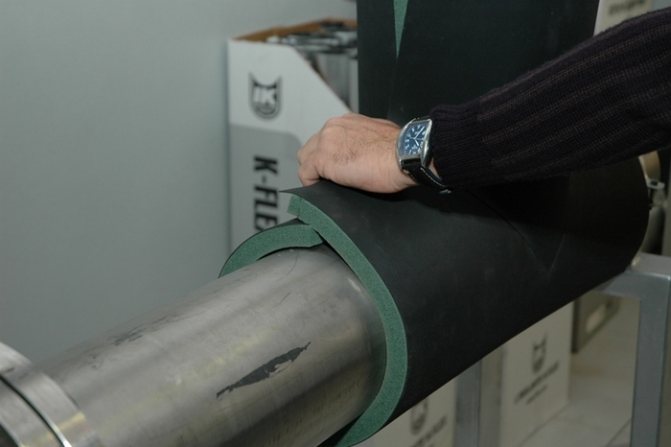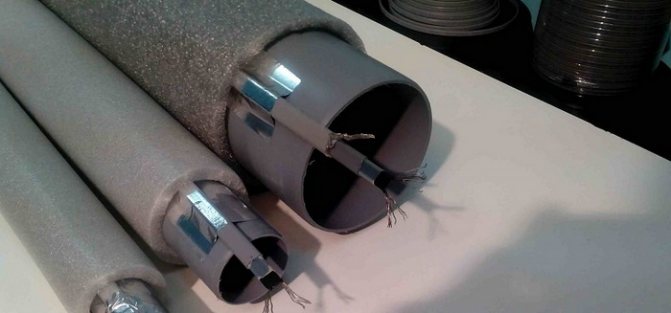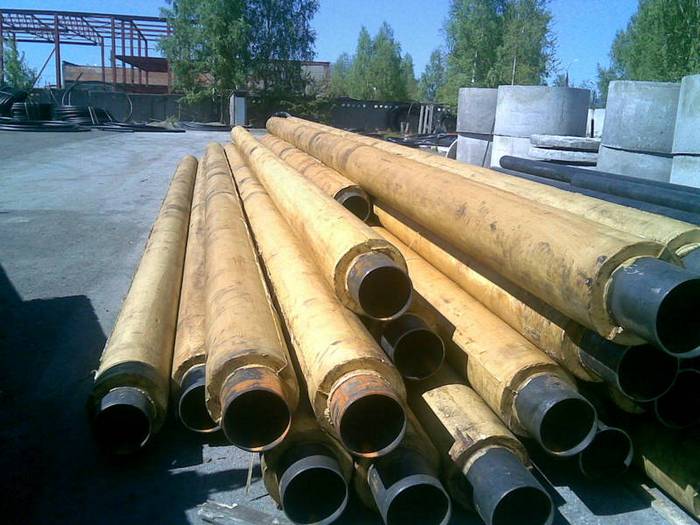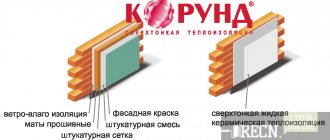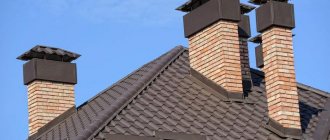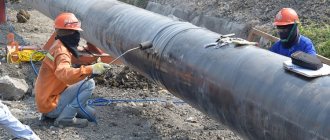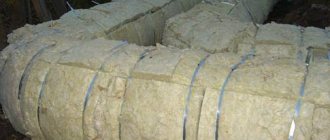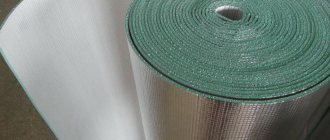Thermal insulation of pipelines is a set of measures aimed at preventing heat exchange of the carrier transported along them with the environment. Thermal insulation of pipelines is used not only in heating systems and hot water supply, but also where technology requires the transportation of substances with a certain temperature, for example, refrigerants.
The meaning of thermal insulation is the use of means that provide thermal resistance to heat exchange of any kind: contact and carried out by means of infrared radiation.
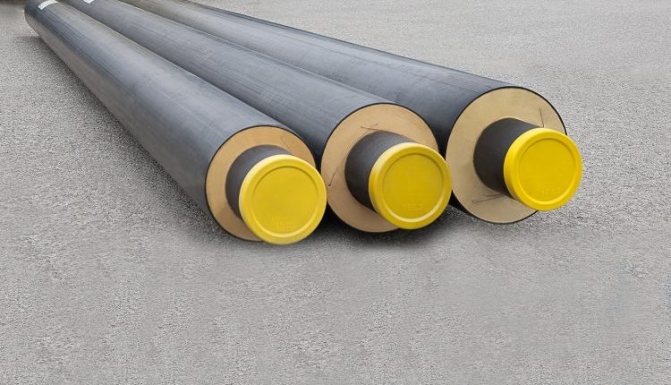
The greatest application, expressed in numbers, is the thermal insulation of pipelines of heating networks. Unlike Europe, the centralized heating system dominates the entire post-Soviet space. In Russia alone, the total length of heating networks is more than 260 thousand kilometers.
Much less often, insulation for heating pipes is used by private households with an autonomous heating system. Only in a few northern regions are private houses connected to the central heating main with heating pipes located outside.
For some types of boilers, for example, powerful gas or diesel boilers, the requirements of the code of rules SP 61.13330.2012 "Thermal insulation of equipment and pipelines" are prescribed separate from the placement building - in the boiler room, which is several meters away from the heated object. In their case, a piece of harness passing through the street must be insulated.
Pipe laying methods
On the street, insulation of heating pipelines is required both for open ground placement and for hidden laying - underground. The last method can be canal - a reinforced concrete gutter is first laid in the trench, and pipes are already placed in it. Channelless placement - directly in the ground. The used insulating materials differ not only in thermal conductivity, but also in steam and water resistance, durability and installation methods.
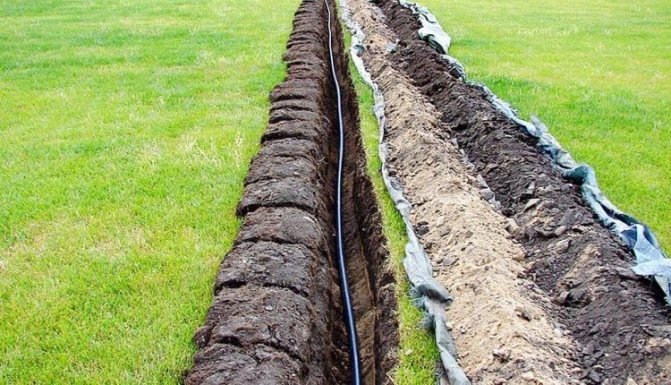

The need to insulate cold water pipes is not so obvious. However, one cannot do without it in the case when the water supply system is laid by an open ground method - the pipes must be protected from freezing and subsequent damage. But inside buildings it is also necessary to insulate water pipes - to prevent moisture condensation on them.
VUS insulation
The definition (concept) of highly reinforced pipe insulation is given as follows: it is a structure covering that possesses:
- minimum culvert capacity;
- resistance to mechanical damage, rust, active chemicals.
The protective shell is made by extrusion and consists of several layers. It can be operated in any region, regardless of climate. The application of very reinforced insulation (VUS) is carried out in accordance with GOST 9.602-89.
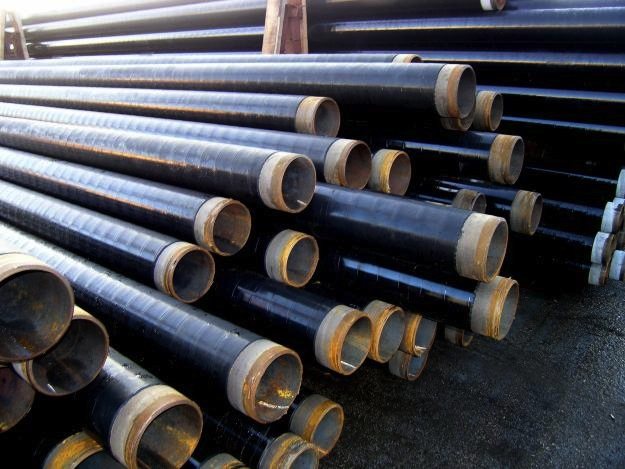

Example of pipes in VUS insulation
Characteristic of highly reinforced piping insulation
The composition of the two-layer external VUS insulation includes a heat-shrinkable component made on the basis of a polyethylene film and a hot-melt adhesive. Polyethylene is laid on metal structures coated with a liquid primer and an adhesive underlay.
The weight of rolled metal after processing increases. Products, the technical level of which is confirmed by certificates, is ready for installation.
Glass wool, mineral wool
Insulating materials, proven by practice.They meet the requirements of SP 61.13330.2012, SNiP 41-03-2003 and fire safety standards for any method of installation. They are fibers with a diameter of 3-15 microns, in structure close to crystals.
Glass wool is made from waste glass production, mineral wool from silicon-containing slag and silicate waste from metallurgy. The differences in their properties are insignificant. They are produced in the form of rolls, stitching mats, plates and pressed cylinders.
It is important to be careful with materials and be able to handle them correctly. Any manipulation should be carried out in protective overalls, gloves and a respirator.


Installation
The pipe is wrapped or covered with cotton wool, ensuring uniform filling density over the entire surface. Then the insulation, without too much crushing, is fixed with a knitting wire. The material is hygroscopic and easily gets wet, therefore, the insulation of external pipelines made of mineral or glass wool requires the installation of a vapor barrier made of a material with low vapor permeability: roofing material or polyethylene film.
A cover layer is placed on top of it, which prevents the penetration of precipitation - a casing made of roofing sheet, galvanized iron or sheet aluminum.
The essence of work on thermal insulation
In the case of pipes for cold water supply, refrigeration equipment or air conditioning, the goal is to prevent freezing of structures, the formation of condensation, and their damage by corrosion. In the field of hot water supply, the task is to reduce heat loss, reduce the cost of maintaining and maintaining the communications system. The task of insulating heating pipelines in the basement and any other communications is to permanently protect the insulated surfaces from internal and external processes arising from an increase in the temperature difference.
All communication elements need insulation and insulation
Additional advantages of using insulating materials are the reduction of sound (noise) effects arising from a drop in loads (pressure due to water pressure).
The principle of operation is the separation of one heat-conducting element from the others, which allows maintaining the initial temperature in the energy carrier, preventing freezing. For this, materials that block heat transfer are used, the calculation of pipeline insulation (type of work, material and its consumption) depends on the type of structure and the conditions of its operation and is carried out individually for each particular case.
The insulating layer protects against heat loss and breakdowns associated with freezing of the coolant
On a note. When using insulation and protection against heat loss, you will save money and time for laying any pipeline system, since regardless of the materials chosen and the type of protective structure, the event will be cheaper than conducting communications underground. In addition, it will increase the service life of the system, reducing the likelihood of premature failure of its elements.
Insulation requirements
Parameters by which materials for pipeline insulation are assessed:
- Energy efficiency is the coefficient of change in heat loss during the declared period of use of the material.
- Durability and reliability - the ability to withstand mechanical, thermal, chemical damage during the service life without reducing the heat-shielding properties.
- Safety, environmental friendliness - the level of danger of the material for the environment and humans during use, disposal (regulated by ФЗ-123).
The characteristics are also taken into account:
- density;
- steam, heat permeability;
- compressibility;
- flammability (the material must be non-flammable or with a high flammability threshold);
- water-repellent properties, water absorption capacity;
- soundproofing characteristics.
Requirements that pipeline insulation must comply with according to SNiP:
- Use for insulation work of complete, prefabricated structures, manufactured at the factory in compliance with the production quality requirements. It is also allowed to use finished pipes with low thermal conductivity, which do not require additional insulation. Applicable to plumbing equipment and airway structures.
- When laying thermal communications, it is necessary to insulate, among other things, reinforcement and flange connections, compensators, regardless of the installation methods and the maximum / minimum temperature of the carrier.
- The insulation thickness of pipelines is regulated in accordance with the type of construction and its purpose. The insulation should consist of the following components: an insulating layer, fasteners and reinforcing parts, a vapor barrier layer, a cover.
Important: the upper protective layer of the working surface of the communication system is not a component of thermal insulation.
Basalt (stone) wool
More dense than glass wool. Fibers are made from melt of gabbro-basalt rocks. It is absolutely non-flammable, withstands temperatures up to 900 ° C for a short time. Not any insulating materials, like basalt wool, can contact surfaces heated to 700 ° C for a long time.
Thermal conductivity is comparable to polymers, ranging from 0.032 to 0.048 W / (m · K). High performance indicators allow using its thermal insulation properties not only for pipelines, but also for arranging hot chimneys.
Available in several versions:
- like glass wool, in rolls;
- in the form of mats (stitched rolls);
- in the form of cylindrical elements with one longitudinal slot;
- in the form of pressed cylinder fragments, the so-called shells.
The last two versions have different modifications, differing in density and the presence of a heat-reflecting film. The slot of the cylinder and the edges of the shells can be made in the form of a spike connection.
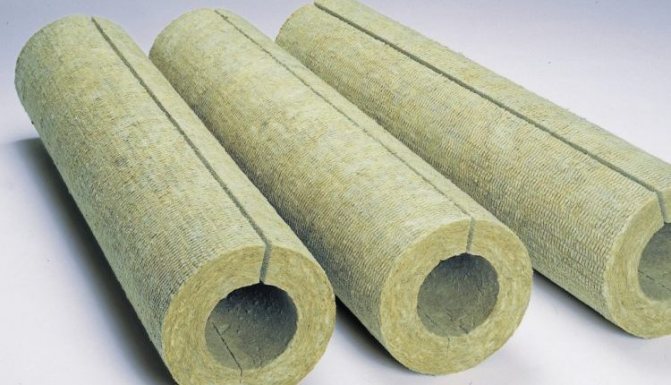

SP 61.13330.2012 contains an indication that the thermal insulation of pipelines must comply with safety and environmental protection requirements. By itself, basalt wool fully complies with this instruction.
Manufacturers often use a trick: to improve consumer performance - to give it hydrophobicity, greater density, vapor permeability, they use impregnations based on phenol-formaldehyde resins. Therefore, it cannot be called 100% safe for humans. Before using basalt wool in a residential area, it is advisable to study its hygiene certificate.
Installation
The fibers of the insulation are stronger than those of glass wool, so the ingress of its particles into the body through the lungs or skin is almost impossible. However, when working, it is still recommended to use gloves and a respirator.
The installation of the roll cloth does not differ from the way in which the insulation of heating pipes with glass wool is carried out. Heat protection in the form of shells and cylinders is attached to the pipes using mounting tape or a wide bandage. Despite some hydrophobicity of basalt wool, pipes insulated with it also require a waterproof vapor-permeable shell made of polyethylene or roofing material, and an additional one made of tin or dense aluminum foil.
Insulating materials for hot water pipelines
Communications transporting hot water ask for the organization of insulation, which is distinguished by a small coefficient of thermal conductivity. This is to reduce the pipe heat loss criteria. Without proper thermal insulation, the pipeline will dissipate heat into the surrounding environment, showing poor performance.
Consider what types of materials for insulation work can be used to secure a pipeline transporting hot water:
- Foam Polymer Mineral Pipe Insulation (PPM) is an insulation material obtained by mixing artificial latex foam and mineral filler.
PPM insulation is mainly used exclusively for pipelines for hot water supply. PPM insulation consists of three main layers with different densities. PPM insulation is considered a universal protection design, since any of its layers has its own function: protection against corrosive processes, thermal insulation and protection against the negative effects of moisture. Such a monolithic structure is resistant to temperature extremes, and also stands out for its remarkable reliability, which makes it possible to protect the pipeline structure from the effects of mechanics.
Helpful information! Insulation of pipelines can be both external and internal. Internal pipe insulation has two main functions: protecting the pipe from corrosive influences and increasing the throughput of the pipeline.
- artificial latex (PPU). This material is used mainly in order to increase the waterproofing criteria of communication. It stands out for its good thermal stability and can withstand temperature drops. Among other things, it should be noted that the heat loss during the organization of artificial latex insulation is no more than 5%.
- very strong insulation (VUS). This is a special type of insulation, which consists of 2 or three layers and is used to protect pipeline communications from the harmful effects of corrosion. And it must also be stated that VEG is resistant to low temperatures and can be used in unfavorable climatic conditions.
Very strong insulation is used to protect highways operating in difficult climatic conditions
Foamed polyurethane (polyurethane foam, polyurethane foam)
Reduces heat loss by more than half compared to glass wool and mineral wool. Its advantages include: low thermal conductivity, excellent waterproofing properties. The service life declared by the manufacturers is 30 years; The operating temperature range is from -40 to +140 ° С, the maximum withstand for a short time is 150 ° С.
The main brands of PPU belong to the G4 flammability group (highly flammable). When changing the composition with the addition of fire retardants, they are assigned G3 (normally combustible).
Although polyurethane foam is excellent as an insulating material for heating pipes, keep in mind that SP 61.13330.2012 allows the use of such thermal insulation only in single-family residential buildings, and SP 2.13130.2012 limits their height to two floors.
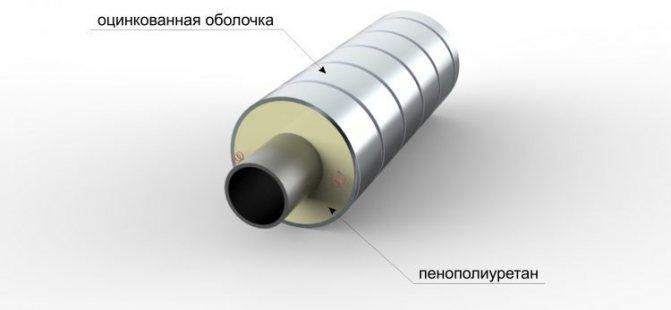

It might be interesting
Thermal insulation
Distinctive features and variety of ceiling tiles ...
Thermal insulation
How to insulate the ceiling in a wooden house?
Thermal insulation
What is a heating cable?
Thermal insulation
Warm "pie" for a metal chimney
The thermal insulation coating is produced in the form of shells - semicircular segments with tongue-and-groove locks at the ends. Ready-made steel pipes are also commercially available, insulated from polyurethane foam with a protective sheath made of polyethylene.
Installation
The shells are fixed to the heating pipe with ties, clamps, plastic or metal band. Like many polymers, the material does not tolerate prolonged exposure to sunlight, therefore, an open ground pipeline when using PU foam shells needs a cover layer, for example, of galvanized steel.
For underground channelless placement, heat-insulating products are laid on waterproof and temperature-resistant mastics or adhesives, and outside they are insulated with a waterproof coating. It is also necessary to take care of anti-corrosion treatment of the surface of metal pipes - even the glued snap joint of the shells is not tight enough to prevent condensation of water vapor from the air.
Insulation of an underground gas pipeline
Insulation of a gas pipeline located underground is needed to eliminate the appearance of pipe rust (due to moisture in the soil). Among other things, it should be emphasized that the insulation of gas pipes is also needed to protect communications from stray currents.
You need to pay attention! Stray currents appear, for example, if a gas pipeline passes next to roads and railways. And stray currents can appear in the soil due to the power cables laid in it.
Stray currents have a detrimental effect on the walls of the gas pipeline, which leads to their rapid wear and tear. Steel pipes, which can fail during a year of operation, are especially well suited to destruction from such currents; in such cases, first of all, insulation of steel underground gas mains is needed. Otherwise, a gas leak may appear, which can lead to serious consequences.
For underground gas pipelines, pre-insulated pipes are often used, for example, made of artificial latex.
Artificial latex (PUF) is perfect for insulating underground gas mains. It should be emphasized that there are two key ways to apply insulation to gas pipes:
- preparatory pipe insulation (application of an insulator to a pipe in production);
- installation of insulation material after laying communications.
The pipe, separated by artificial latex at the manufacturing stage, is a more reliable and durable solution. In order to ensure high-quality waterproofing of the pipe, the layer on top of the sheath is provided mainly by polymeric ethylene.
And it is also necessary to emphasize one more main advantage of such insulation - the possibility of organizing electronic control over the gas pipe. This is a very good function, which makes it possible to very quickly detect a breakdown in the line. In addition to everything else, it should be noted that such pipes are distinguished by a rather democratic cost. All of the above positive qualities made it possible for pipes with polyurethane foam insulation to take first positions in the building materials market.
Expanded polystyrene (polystyrene, PPS)
It is produced in the form of shells, which outwardly practically do not differ from polyurethane foam - the same dimensions, the same tongue-and-groove joint. But the application temperature range, from -100 to +80 ° C, with all this external similarity makes it impossible or limited to use it for thermal insulation of the heating pipeline.
SNiP 41-01-2003 "Heating, Ventilation and Air Conditioning" states that in the case of a two-pipe heat supply system, the maximum supply temperature can reach 95 ° C. As for the return heating pipes, everything is not so simple here: it is believed that the temperature in them does not exceed 50 ° C.
Foam insulation is more often used for cold water and sewage pipes. However, it can be used over other insulation materials with a higher permissible application temperature.
The material has a number of some disadvantages: it is highly flammable (even with the addition of fire retardants), it does not tolerate chemical influences (it dissolves in acetone), and falls into balls upon prolonged exposure to solar radiation.
There are other non-polystyrene foams - formaldehyde, or, in short, phenolic. In fact, this is a completely different material. It is devoid of these disadvantages, it is successfully used as thermal insulation for pipelines, but it is not so widespread.
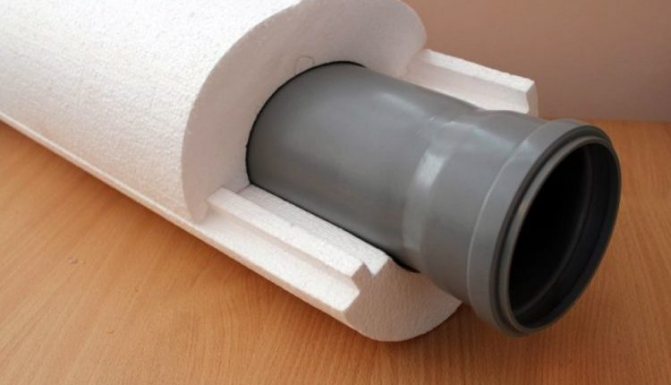

Installation
The shells are fixed to the pipe using a bandage or foil tape, it is allowed to stick them to the pipe and to each other.
Types of pipeline insulation and their features
A pipeline is a technical device used to transport gaseous, liquid and solid substances (oil products, water, etc.). Regardless of the substances being transported, these structures need anti-corrosion, thermal and waterproofing protection.
Most often, pipes are laid underground, which is why their outer insulating layer has to come into contact with groundwater. Those pipelines that are outside buildings and are not buried in the ground are exposed to the adverse effects of atmospheric precipitation, ultraviolet radiation, and temperature extremes. That is why the choice of thermal insulation should be approached as responsibly as possible. A poor-quality insulating layer often causes premature failure of pipes, which means unforeseen material costs.
To protect the pipeline from negative environmental factors, bitumen, polyurethane foam (PPU), glass wool, mineral wool, etc. are used. The main types of insulation and their characteristic features will be discussed below.
Bitumen
The peak of popularity of bitumen insulation falls on the end of the 90s of the last century, while it is still used today. This shell is externally represented by a thin layer of polyethylene protected by a bituminous coating. In the case of insulating underground pipelines, fiberglass is additionally used.
The use of bitumen in main pipelines prevents the formation of corrosion on the surface of pipes that come into contact with soil saturated with moisture and various chemical elements. If the external laying of the pipeline is supposed, then this material can withstand from -40 ° C to +65 ° C. With deep laying, the temperature range is reduced to -5 ... + 30 ° С.
The bitumen-polymer composition is the embodiment of reliability, efficiency and economy. Through it, pipelines are isolated as soon as possible. Bitumen is used to protect steel pipes that carry oil, gas and water.
Polyurethane foam shells and shells
Currently, PU foam shells are in good demand. Their characteristic feature is their reusability. Such protective structures are used in cases of underground (channel / channelless) and outdoor installation of pipes.
In the factory, polyurethane foam insulation is produced as follows: a directed stream of liquid material is fed into the space between the inner steel pipe and the outer polyethylene insulation layer. After that, the time required for the components to harden and acquire the desired shape is maintained. If we consider this procedure in more detail, then it consists of the following stages:
- before coating metal pipes with protection, they are cleaned by shot blasting. This stage cannot be neglected, since the quality of adhesion between the surfaces of the pipeline and protection depends on it. In addition, the pollution formed during operation (dirt, scale, rust) simply disappears;
- application of a polyethylene shell, however, a corona discharge is necessary here.
A polyurethane foam sheath is required in situations where it is planned to lay pipes underground using galvanized insulation. When it comes to the organization of the external pipeline, then the shell of polyurethane foam should be coated with acrylic / silicone paint, as this will protect the pipes from damage caused by direct sunlight.
Glass wool
Glass wool is the most popular insulation used to protect heat pipelines. Some of the most demanded insulation today are Rockwool and Izotek. It should be noted that Izotek mesh mats eliminate heat loss and condensation in communications.
Mineral wool
This material is actively used for insulation of heating mains.Mats and shells are made of mineral wool for a certain diameter of pipes, on top of which a special coating is laid. This layer consists of galvanized and asbestos-cement sheets, which protects the heat pipe from exposure to sunlight, which changes the composition and properties of the heat-insulating material.
Polyethylene
Polyethylene insulation is mainly used to protect pipelines from corrosion. This coating is considered combined and is applied in several layers. Moreover, it can be used only in production conditions. The practicality of this material is due to the minimum amount of time required for its hardening. That is why it is used, as a rule, for laying oil trunk pipelines.
Foamed polyethylene
The temperature range at which the use of high-pressure polyethylene foam is allowed is from -70 to +70 ° C. The upper limit is not compatible with the maximum temperature of the heating pipe, usually taken in calculations. This means that the material is of little use as thermal insulation for pipelines, but it can be used as an insulating layer on top of a heat-resistant one.
Polyethylene foam insulation has found almost no alternative application as protection against freezing of water pipes. It is very often used as a vapor barrier and waterproofing.
The material is produced in the form of sheets or in the form of a flexible thick-walled pipe. The latter form is more often used, since it is more convenient for insulating a water supply system. The standard length is 2 meters. The color ranges from white to dark gray. It is possible to have a coating of aluminum foil that reflects infrared radiation. The differences relate to internal diameters (from 15 to 114 mm), wall thickness (from 6 to 30 mm).


The application ensures that the temperature on the pipe is above the dew point, and therefore prevents the appearance of condensation.
Installation
An easy way with the worst vapor control results is to cut the foam material in a small indentation along the side surface, open the edges and put it on the pipe. Then wrap the entire length with mounting tape.
A more difficult solution (and far from always feasible) is to shut off the water, completely disassemble the insulated sections of the water supply and put on solid sections. Then put everything back together. Secure the polyethylene with ties. In this case, only the junction of the segments will become a vulnerable spot. It can be glued or also wrapped with tape.
Reinforced type protective coating structure
Construction and coating material | Layer thickness or number of layers |
| 1. Coatings based on bituminous mastics | |
| Bituminous primer | 0.05 mm |
| Bituminous mastic | 2.5 mm |
| Reinforcing winding | — |
| Bituminous mastic | 2.5 mm |
| Reinforcing winding | — |
| Bituminous mastic | 2.5 mm |
| Outer wrap | — |
| 2.Coating based on polymer adhesive tapes | |
| Primer (primer) | 0.1 mm |
| Duct tape | 2 layers |
| Wrapper | 1 layer |
| 3. Coverings from extruded polyethylene | |
| Adhesive | 0.15 |
| Extruded polyethylene for pipes with a diameter of 500 mm and above | 3.5 mm |
Note: It is allowed to apply coatings of other structures that provide protection according to the normative-technical documentation.
Before applying the primer, the surface of the insulated pipes is dried, cleaned of dirt, rust, loosely adhered to metal, scale and dust. After cleaning, the metal surface must be roughened to ensure, together with the primer, sufficient adhesion of the insulating coating to the pipe. The pipes are cleaned with special cleaning machines. Shaped surfaces and welded areas are cleaned by hand with flat or rotating brushes. The primer is applied immediately after cleaning the pipe surface, in an even layer without gaps, clots and bubbles. The thickness of the dried primer layer should not exceed 0.05 mm.The pipe must be coated no later than one day after the primer is applied.
The mastic is applied along the circumference and length of the pipe in an even layer of a given thickness without bubbles and foreign inclusions. A layer of fiberglass reinforcing winding should be applied to the hot mastic in a spiral with an overlap and a certain tension, eliminating voids, wrinkles and folds and ensuring the continuity of the layer and the required thickness of the protective coating.
Insulation work in winter in route conditions is allowed at an air temperature of at least minus 25 ° C and in the absence of atmospheric precipitation. Bituminous mastics are recommended for use on gas pipelines with a diameter of up to 500 mm and an operating temperature of up to 35 ° C. The reliability of the bituminous coating increases significantly with the increase in the number of reinforcing layers of glass fiber with the use of protective wrappers. As a polymer mastic, the two-component Frusis-1000A mastic is currently the most effective. The mastic is applied in route conditions and is intended for anti-corrosion protection of hot sections of underground communications of compressor stations.
The time for the hardening of the mastic is 30 ... 60 min.,
Thickness of the applied coating 2.5 ... 3.0 mm,
Operating temperature up to 80 ° C.
Foamed rubber
Closed-cell foam synthetic rubber is the most versatile material for keeping warm and cold. Designed for a temperature range from -200 to +150 ° C. Complies with all environmental safety requirements.
It is used as insulation of cold water pipelines, insulation of heating pipes, often found in refrigeration and ventilation systems. Heating pipes installed inside buildings and insulated with rubber do not require a vapor barrier.
Externally similar to expanded polyethylene, it is also produced in the form of sheets and flexible thick-walled pipes. Installation is also practically the same, except that such thermal insulation of pipes can be attached with glue.


Insulating materials for pipelines transporting cold water
To isolate communications that transport cold water, the following insulator options are used:
- heat insulator based on basalt fiber. This pipe insulation comes in different sizes and is produced in the form of a cylinder. The main advantage of this heat insulator is that no special trays are needed to install the pipeline, and this type of insulation is also the most effective for communications transporting cold water. Among other things, the organization of basalt insulation does not require any specialized construction skills and stands out for its high speed.
- foamed rubber (VK). This material has excellent waterproofing properties, and is also able to withstand temperature fluctuations. Has a closed pore structure. Basically, this insulator comes in the form of tubes or plates. And it is also necessary to highlight that foamed rubber is considered a fire-resistant material and, in the event of ignition, is self-extinguishing.
- mineral mats. They are made of mineral wool and are used to insulate large-diameter pipelines. Depending on the design properties, there are 3 types of mineral mats: stitched, foil, lamellar.
- fiberglass. This material is not considered self-sufficient and is only used in a configuration with other insulators (for example, with fiberglass). Basically, fiberglass mats are used instead of this material. The installation of fiberglass mats is carried out exactly like this: first of all, the pipeline is wrapped with mats, then they are fixed with ordinary wire and, finally, the resulting structure is wrapped with polymeric ethylene.This method is considered inconvenient and labor-intensive, however, such thermal insulation has shown itself to be excellent and is considered very effective.
- foamed polyethylene (VPE). Such an insulator is made in the form of tubes that have a longitudinal section. The installation of pipes made of VPE stands out for its commonness and high speed. WPE is an environmentally safe material that can withstand temperature fluctuations, and is also considered resistant to aggressive chemicals based on chemistry. The use of VPE makes it possible to exclude the appearance of mold and mildew.
Foamed polyethylene cylinders are used to insulate cold pipelines in industry and everyday life
- polyurethane foam (PPU) spraying. This method, from a material point of view, is very expensive, but also very productive when compared with other options for thermal insulation of pipes. To apply polyurethane foam to the pipe, special nozzles are used. After contact with air, the artificial latex hardens and forms a dense protective coating that is highly resistant to low temperatures.
Helpful information! It should be emphasized that very often after the installation work of the foam shell has been carried out, additional waterproofing is applied on top. As a rule, traditional polymeric ethylene acts as such protection against the negative effects of moisture.
- expanded polystyrene. Foam insulators are made in the form of a specialized shell, which can be easily put on the pipe. This material is considered the most common due to its ease of installation. Foam shells are usually coated or made without coating.
- liquid insulation for pipes. This is a rather specific way to protect pipes from low temperatures. This option of thermal insulation is rarely used. The method is based on the application of a specialized heat-resistant paint to the pipe.
